Maths: ordering numbers
This week, we have been comparing and ordered two digit numbers from the smallest to the greatest and from the greatest to the smallest and using the < (less than) and > (greater than) symbols.



Help at home: Choose 3 two digit numbers and order them.
Challenge: Can you add in the < (less than) and > (greater than) symbols?
Topic: Local walk to Sandringham Park
On Tuesday, we went to Sandringham Park to answer our fieldwork question.
What types of green spaces are in our locality and what are they used for?
How could they be improved?
We walked sensibly and safely to the park and when we arrived we thought about the following questions:
- Is there a playground?
- Are there places to sit down?
- How many rubbish bins can you see?
- Is there an area to walk dogs?
- How does the park keep people and animals safe?
- Why do you think the council want to change this green space?
- How did we stay safe during our fieldwork?
Help at home: Talk with your child about other green spaces in your local environment. What are they used for? Could they be improved?

20.10.23
Please practise ready for a spelling quiz on Thursday 26 October 2023.
- are
- ask
- be
- by
- come
- do
- for
- friend
- full
- go
Reading: Tom Palmer
This year, some children at school attended an online workshop with author Tom Palmer. Tom Palmer has been in touch to let us know about some local events he is attending in half term.
Message from Tom
For children and families – I am also coming to Leeds on Thursday 2 November 2023 :
* Farsley Book Festival – 10am-11am more here
https://trumanbooks.co.uk/event/flf-kids-day
* Chapel Allerton Library – 2pm
* Pudsey Community Hub and Library – 4pm

Football Skills with Jamie Knight
On Tuesday, we enjoyed an assembly from the freestyle footballer Jamie Knight and we had a workshop with him where he taught us how to do some of his football skills. Have a look at some of the fun we got up to!













L&L Identity: self-respect
This week, during our Living and Learning session we thought about how we are similar and different from each other.
There are things that are the same or different that are immediately obvious (physical features) as well as things you cannot see such as things you like doing. We worked with our partner to think of an example of each.
“We are the same because we have blue eyes and we both like playing football.”
“We are different because we have different coloured hair but we are the same because we both like gymnastics.”
We had a chat about how there are lots of things the same about us all but everyone is different too – nobody is exactly the same, everyone is unique. No-one is good at everything but everyone is good at something.
Help at home: Draw a picture of your friend, making sure you draw something that makes them special or unique. This could be a physical attribute or something they do. Bring your drawing in to share with us.
Forest School
The children have been enjoying their Forest School sessions on a Friday.
So far, they have enjoyed den building, peeling a stick and decorating using coloured wool and using flint and steel to start a fire on a cotton wool bud.
Help at home: Talk with your child about how to keep safe while at Forest School. For example listen to the adult instructions, only light fires with a flint under adult supervision.













Maths: Place Value
This half term, we’re focussing on Place Value in Maths. Numbers are very important so it is important we know everything we can about numbers 0-100. We have been using base ten, place value charts and part-part-whole models to recognise which number represents the ‘tens’ and which represents the ‘ones’. We’re now thinking about how a number can be partitioned flexibly and we’ve used base tens and part whole models to show this practically.
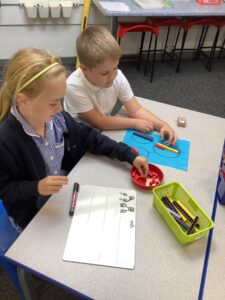
Help at home: draw a part whole model and partition numbers to 100. Use the stem sentence to consolidate the learning.
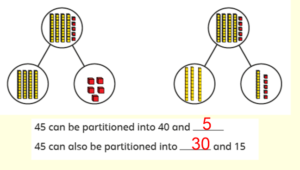
Topic: Seas surrounding the UK and maps
We’re really enjoying our Geography topic. We’ve enjoyed using an atlas to locate and name the four seas surrounding the UK.
Help at home: Can your child name the four seas surrounding the UK? (Irish Sea, English Channel, Atlantic Ocean and North Sea)

We’ve also used Google Earth to help us understand what a map is and we’ve looked at some examples of maps to help us learn how to read a map key.


We looked at a map and used the key provided to answer the questions. We then added some of our own symbols to the key and thought about why maps are useful.


Help at home: Talk with your child about how maps are useful to help us to keep safe? What should you do if you were lost and you didn’t have a map? Here are some of the responses we talked about in class.
“They show you where to go to keep you safe. Like where the hospital or fire station is.”
“They help you if you are lost!”
“You could ask someone around you for help (if there is someone to ask).”
“You should stay where you are and your grown-ups will come and find you.”
RE – The Creation Story
This half term, we are reading, learning and thinking about The Creation Story (This is a YouTube link. Top tip for watching YouTube with your child: go to the settings cog along the play bar and turn off autoplay – this avoids an inappropriate clip coming up automatically, and helps to discourage your child from passively watching clip after clip).
In our lessons so far, we have ordered the Creation Story and thought about the following questions:
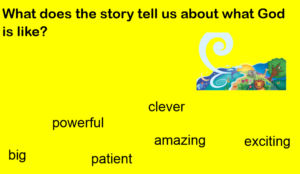
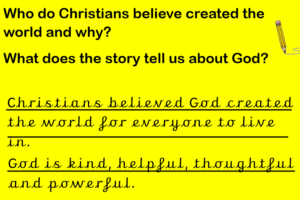
We’ve also looked at two pieces of art by artists who used The Creation Story as inspiration. Thinking about the following questions together:


‘Breisheit’ (In The Beginning) by Jackie Olenick
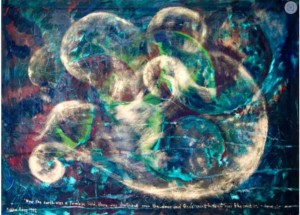
‘Premordial chaos’ by Judy Racz
“It’s all the days of the story in one painting. I can see the sea, the sky and the land”
“I like how the colours are nice and bright”
“I can see the different days from the story in each picture”
We then created our own piece of art.
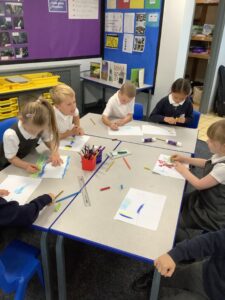
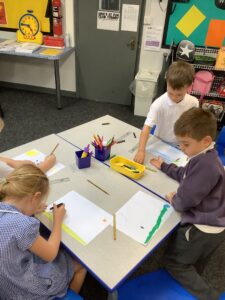
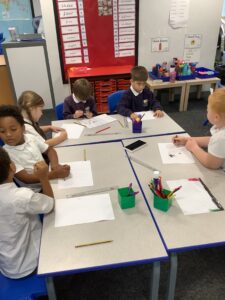
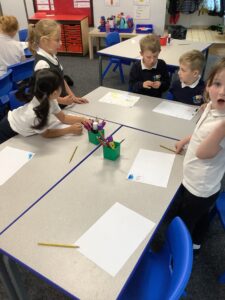
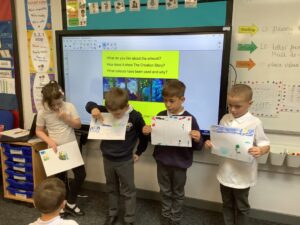
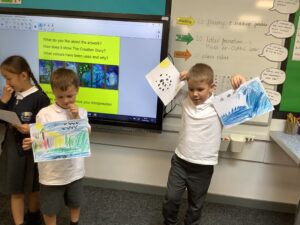
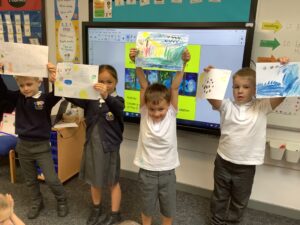

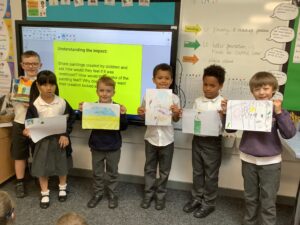
Help at home – Ask your child to retell The Creation Story to you. What do they think the story tells us about God?